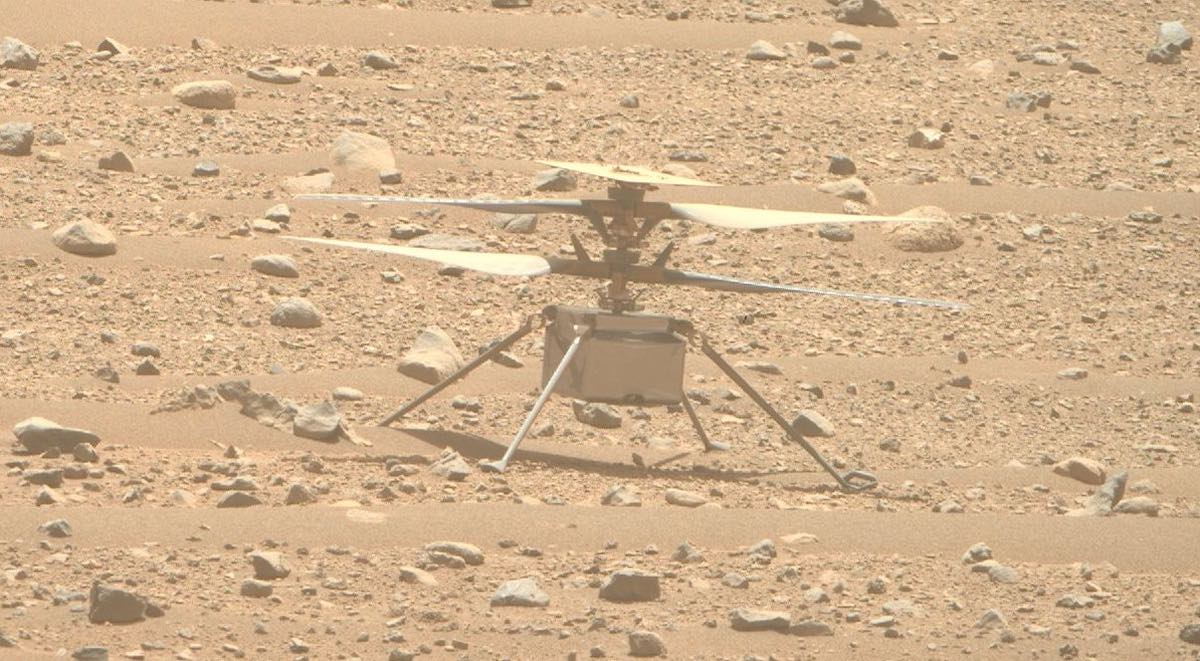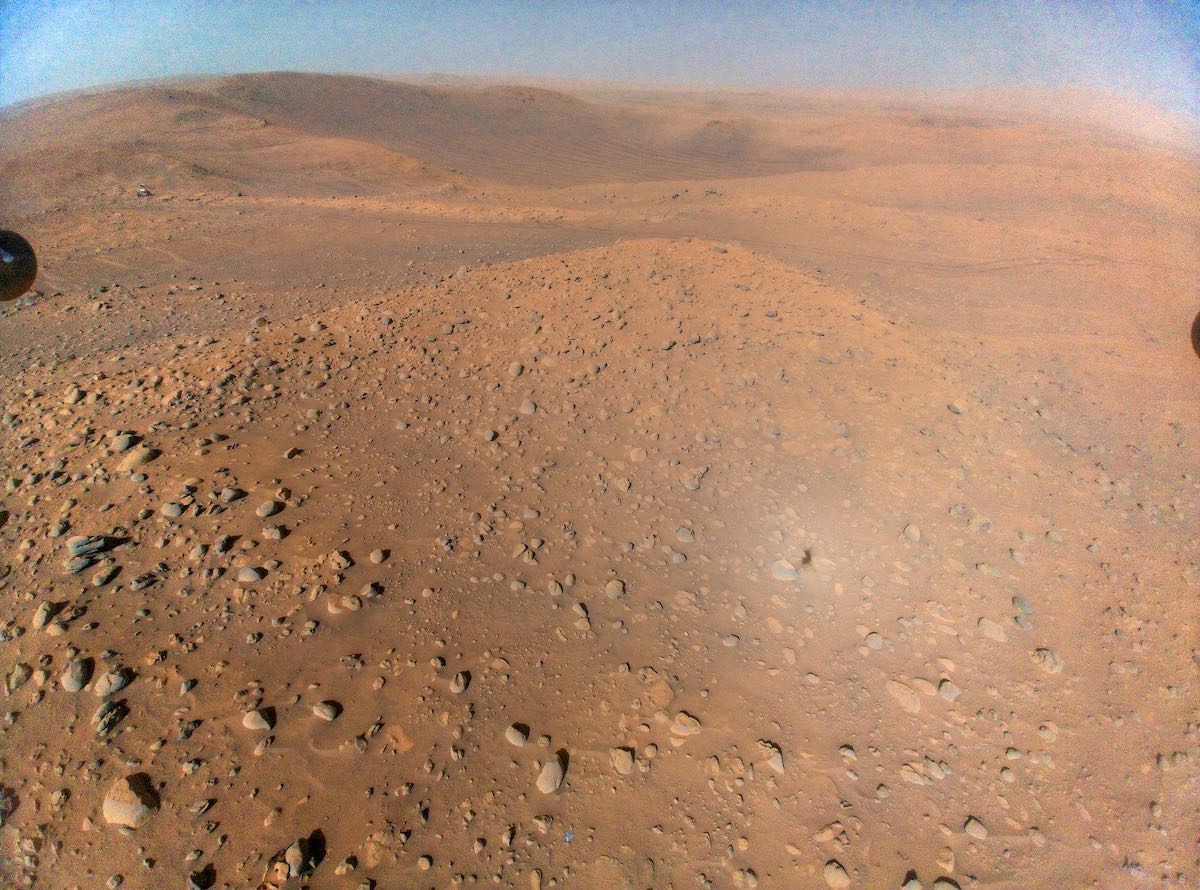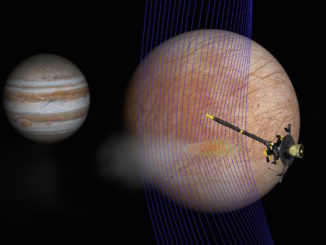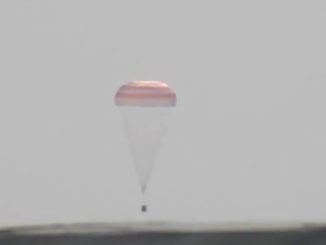
NASA’s pioneering Mars helicopter Ingenuity continues to outperform its design specifications, having now notched up more than 50 record-breaking forays across the Red Planet’s surface, 10 times as many flights as originally planned for.
Ingenuity’s historic 50th flight took place on April 13, when it flew 1,057 feet (322.2 meters) in just under three minutes and reached a record altitude of 59 feet (18 meters) before descending into Belva Crater, which stretches for about half a mile.
Five days later, its mothership the Perseverance rover, which carried Ingenuity to Mars in 2021, traveled to within only 75 feet (23 meters) of the helicopter, its closest ever approach in the mission to date.
Perseverance took the opportunity to snap a series of closeup photos which show the helicopter’s rotors coated in Martian dust that was likely kicked up by Ingenuity during takeoff, hovering and landing maneuvers.
Ingenuity is the first machine to achieve powered flight across the skies of an alien world – a significant accomplishment given that the thin Martian atmosphere makes it difficult to achieve lift. To counteract this, Ingenuity is equipped with enlarged, specially shaped blades that rotate about 10 times faster than what is needed to fly on Earth.
The Mars helicopter’s first flight took place on April 19, 2021, some two months after it landed attached to the Perseverance rover in Jezero Crater. Since then the helicopter has far exceeded its originally planned technology demonstration mission of up to five flights.
At the outset, engineers hoped Ingenuity would be able to show that a solar-powered drone could function in the extremely thin atmosphere of Mars – but the experiment has ended up wildly exceeding expectations. Ingenuity is no longer a simple technology demonstrator but has become an integral part of Perseverance’s operations.
It also serves as an “airborne” scout for Perseverance — which is searching for evidence of past microbial life and collecting samples for future return to Earth — and its successful test of powered flight on another world could aid in future sample return missions from Mars.
“Just as the Wright brothers continued their experiments well after that momentous day at Kitty Hawk in 1903, the Ingenuity team continues to pursue and learn from the flight operations of the first aircraft on another world,” said Lori Glaze, director of the planetary science division at NASA Headquarters in Washington.
Beyond facing more challenging terrain, Ingenuity will also now fly at a greater frequency in the coming weeks because the helicopter needs to remain within electronic earshot of Perseverance, which with its AutoNav capability can travel hundreds of meters each day.
“Ingenuity relies on Perseverance to act as a communications relay between it and mission controllers here at JPL,” explained Josh Anderson, Ingenuity operations lead at NASA’s JPL in California. “If the rover gets too far ahead or disappears behind a hill, we could lose communications. The rover team has a job to do and a schedule to keep. So it’s imperative Ingenuity keeps up and is in the lead whenever possible.”

Built with many “off-the-shelf” components, such as smartphone processors and cameras, Ingenuity is now 23 Earth months and more than 45 flights beyond its expected lifetime. The helicopter has flown for over 89 minutes and more than 7.1 miles (11.6 kilometers).
“When we first flew, we thought we would be incredibly lucky to eke out five flights,” said Teddy Tzanetos, Ingenuity team lead at JPL. “We have exceeded our expected cumulative flight time since our technology demonstration wrapped by 1,250 percent and expected distance flown by 2,214 percent.”
Surpassing expectations like this comes at a cost, however. With some helicopter components showing signs of wear and the terrain becoming more challenging, the Ingenuity team recognizes that every great mission must eventually come to an end.
“We have come so far, and we want to go farther,” added Tzanetos. “But we have known since the very beginning our time at Mars was limited, and every operational day is a blessing. Whether Ingenuity’s mission ends tomorrow, next week, or months from now is something no one can predict at present. What I can say is that when it does, we’ll have one heck of a party.”
During its 51st flight on April 22, Ingenuity returned Perseverance’s photo compliment by taking a spectacular image of the rover from 40 feet (12 meters) above the Martian surface. In the photo, Perseverance can be seen motionless in the planet’s red soil in the background, nearly indistinguishable from large rocks strewn across the Red Planet landscape.



